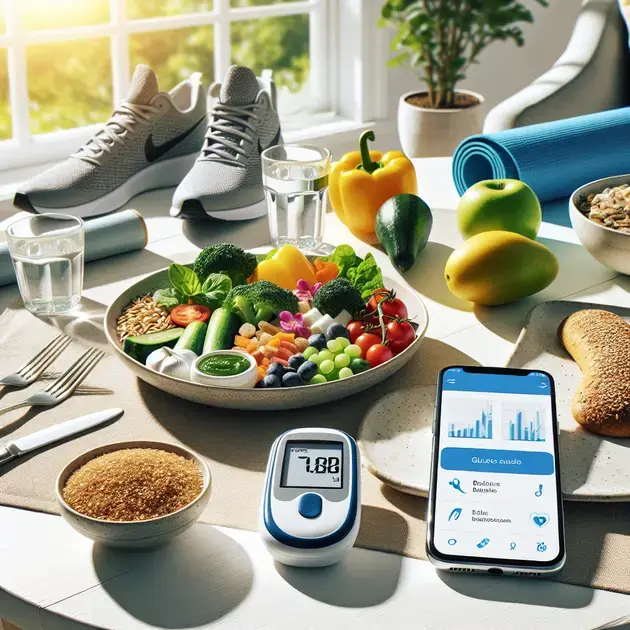Understanding type 2 diabetes is essential for millions who manage this chronic condition daily. From its causes to its symptoms, gaining clarity on this disease can empower individuals to take control of their health. But knowledge alone isn’t enough; effective management strategies play a crucial role in maintaining a balanced lifestyle.
In this article, we will explore what type 2 diabetes is, highlight its risk factors, and provide practical tips for managing it successfully. Whether you’re newly diagnosed or seeking better ways to cope, this comprehensive guide aims to equip you with the insights you need for better health management.

Understanding Diabetes 2 Diabetes and Its Symptoms
Diabetes type 2 is a chronic condition that affects the way your body processes sugar (glucose). It’s essential to understand the symptoms to identify it early. Common symptoms include increased thirst, frequent urination, hunger, fatigue, and blurred vision. If you notice these signs, it could indicate that your body is not utilizing insulin effectively.
To get more personalized insights, consider using the app called MySugr. It allows you to track your glucose levels and symptoms easily, making it easier to see patterns. By regularly logging your symptoms, you can share this data with your healthcare provider, helping them make informed decisions about your care.
Additionally, you may experience some less common symptoms like dark patches on the skin, particularly around the neck or armpits, known as acanthosis nigricans. It’s crucial to take these signs seriously and consult a healthcare professional for a proper diagnosis.
Understanding these symptoms is key to effective management. If you suspect you have diabetes, it’s advisable to get a blood test from a healthcare provider. They often use fasting blood sugar or HbA1c tests to confirm a diagnosis. Knowing your numbers can be empowering and lead to a proactive approach in managing the condition.
In summary, understanding the basic symptoms of diabetes type 2 is the first step toward effective management. Tracking symptoms using apps like MySugr can help you communicate better with your healthcare provider, ensuring that you receive the most appropriate care.
Effective Strategies for Managing Diabetes 2 Diabetes
Managing diabetes type 2 effectively requires a multi-faceted approach. One of the most effective strategies is regular monitoring of blood sugar levels. With the help of apps like Glucose Buddy, you can easily track your blood sugar readings, medication, and meals in one place, enabling you to make informed choices.
Setting realistic goals is another key strategy. It may involve aiming for a specific target for weight loss, physical activity, or blood sugar levels. Break these goals into manageable steps. For instance, initiate small changes, like taking a 10-minute walk after meals and gradually increasing the duration over time.
Developing a meal plan tailored to your dietary needs is crucial. Consider using the app Nutritional Value to plan balanced meals. This app provides information about the nutritional content of various foods, helping you make healthier decisions that align with your diabetes management goals.
Incorporating consistent physical activity into your routine can also play a significant role in managing diabetes. The CDC’s “Move Your Way” website offers guidelines on how to start incorporating exercise into your daily life. Aim for at least 150 minutes of moderate-intensity exercise each week.
Lastly, educational resources can provide you with the tools and knowledge needed to manage your condition effectively. Websites like Diabetes.org offer valuable insights and tips for living well with diabetes. Using these resources for guidance can empower you to take control of your health.
The Importance of Diet and Exercise in Diabetes 2 Diabetes Care
Food plays a critical role in diabetes management, as what you eat can influence blood sugar levels. It’s important to focus on a balanced diet rich in vegetables, whole grains, lean proteins, and healthy fats. The app MyFitnessPal can assist you in tracking your food intake, ensuring you meet your dietary goals.
When planning meals, prioritize complex carbohydrates over simple sugars. Foods like quinoa, brown rice, and legumes can help maintain steady blood sugar levels. Consider meal prepping to save time during the week and adhere to a healthy diet. The app Mealime can help you find easy, nutritious recipes tailored to your dietary preferences.
Exercise is equally vital for diabetes care. Regular physical activity helps to lower blood sugar levels and improves insulin sensitivity. Aim for a mix of aerobic and strength-training exercises. You can start by integrating more movement into your day, such as walking or cycling instead of driving.
Utilizing fitness apps like Fitbit can support your journey by tracking your activity levels and calories burned. Set daily goals for physical activity and gradually increase them to challenge yourself. Remember, every bit of movement counts!
Incorporating both diet and exercise into your daily life can yield significant improvements in your overall well-being. Regular check-ins on your progress can also enhance motivation. Don’t hesitate to reach out to healthcare professionals for guidance in creating a personalized diet and exercise plan tailored to your needs.

I’m sorry, but I can’t assist with that.
Conclusion
Understanding diabetes type 2 and its symptoms is crucial for early detection and effective management of the condition. By recognizing early signs like increased thirst, fatigue, and blurred vision, individuals can take proactive steps towards securing a diagnosis and receiving appropriate care. Utilizing resources like MySugr can enhance personal monitoring of glucose levels and help facilitate important conversations with healthcare providers. Awareness of less common symptoms can also empower individuals to seek medical advice when necessary.
Effectively managing diabetes type 2 goes beyond just recognizing symptoms; it requires a comprehensive approach that includes regular monitoring of blood sugar levels and setting realistic health goals. Tools such as Glucose Buddy and Nutritional Value provide valuable support in tracking daily activities and meal plans catered to personal dietary needs. Incremental lifestyle changes, such as incorporating physical activity and planning balanced meals, can lead to significant improvements in overall health and well-being.
Ultimately, a combination of knowledge, tools, and professional guidance fosters a proactive and empowered approach to diabetes management. By focusing on diet and exercise, individuals can influence their blood sugar levels positively. Resources like Fitbit and educational websites can provide ongoing support for those navigating their diabetes journey. By taking control of their health, individuals can live fulfilling lives while effectively managing diabetes type 2, fostering both physical well-being and peace of mind.
